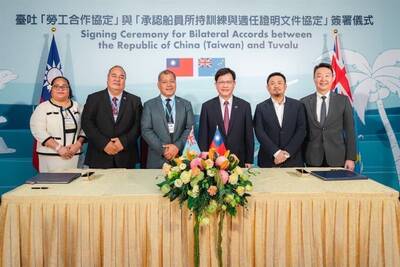The Ministry of National Defense yesterday said that it detected 14 Chinese air force planes operating around Taiwan and carrying out “joint combat readiness patrols” with Chinese warships.
China has over the past four years regularly sent warplanes and warships into the skies and waters around Taiwan, as it seeks to assert sovereignty claims that the Taipei government rejects.
The ministry said that starting at about 1pm yesterday, it had detected 14 Chinese aircraft — including J-16 fighters and drones — operating off northern and southwestern Taiwan.

Photo: Chang Chia-ming, Taipei Times
Nine of those aircraft crossed the Taiwan Strait’s median line, or areas close by, working with Chinese warships to carry out “joint combat-readiness patrols,” the ministry added.
There was no immediate response from the Chinese Ministry of National Defense. China is in the middle of its week-long Lunar New Year holiday.
Taiwan sent its own forces to monitor, its defense ministry said.
The Strait’s median line once served as an unofficial barrier between the two sides, but Chinese planes now regularly fly over it. China says it does not recognize the line’s existence.
Taiwan last month elected Vice President William Lai (賴清德) as its next president — a man China describes as a dangerous separatist.
Lai, who takes office in May, has offered talks with China, which have been rejected.
He says only Taiwanese can decide their future.

The Ministry of Economic Affairs has fined Taobao NT$1.2 million (US$36,912) for advertisements that exceed its approved business scope, requiring the Chinese e-commerce platform to make corrections in the first half of this year or its license may be revoked. Lawmakers have called for stricter enforcement of Chinese e-commerce platforms and measures to prevent China from laundering its goods through Taiwan in response to US President Donald Trump’s heavy tariffs on China. The Legislative Yuan’s Finance Committee met today to discuss policies to prevent China from dumping goods in Taiwan, inviting government agencies to report. Democratic Progressive Party Legislator Kuo Kuo-wen (郭國文) said

The Ministry of Economic Affairs has fined Taobao NT$1.2 million (US$36,900) for advertisements that exceeded its approved business scope and ordered the Chinese e-commerce platform to make corrections in the first half of this year or its license would be revoked. Lawmakers have called for stricter supervision of Chinese e-commerce platforms and more stringent measures to prevent China from laundering its goods through Taiwan as US President Donald Trump’s administration cracks down on origin laundering. The legislature’s Finance Committee yesterday met to discuss policies to prevent China from dumping goods in Taiwan, inviting government agencies to report on the matter. Democratic Progressive Party

Taiwan and its Pacific ally Tuvalu on Tuesday signed two accords aimed at facilitating bilateral cooperation on labor affairs, according to Taiwan’s Ministry of Foreign Affairs (MOFA). The governments inked two agreements in Taipei, witnessed by Foreign Minister Lin Chia-lung (林佳龍) and visiting Deputy Tuvaluan Prime Minister Panapasi Nelesone, MOFA said in a news release. According to MOFA, the agreements will facilitate cooperation on labor issues and allow the two sides to mutually recognize seafarers’ certificates and related training. Taiwan would also continue to collaborate with Tuvalu across various fields to promote economic prosperity as well as the well-being of their

Sung Chien-liang (宋建樑), who led efforts to recall Democratic Progressive Party (DPP) Legislator Lee Kun-cheng (李坤城), was released on bail of NT$80,000 today amid outcry over his decision to wear a Nazi armband to questioning the night before. Sung arrived at the New Taipei District Prosecutors’ Office for questioning in a recall petition forgery case last night wearing a red armband bearing a swastika, carrying a copy of Adolf Hitler’s Mein Kampf and giving a Nazi salute. Sung left the building at 1:15am without the armband and covering the book with his coat. Lee said today that this is a serious